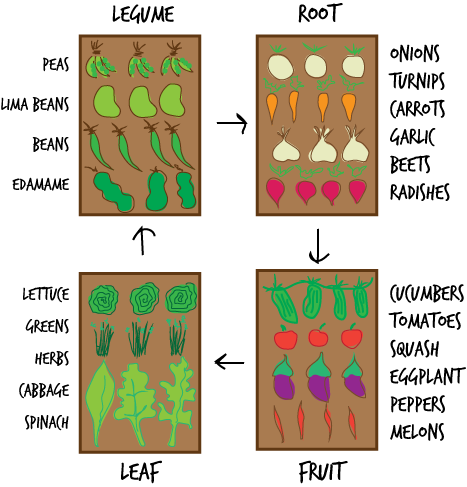Last week we talked about preparing the vegetable garden by pulling the leftover plants and weeds and turning in plenty of new compost. Next we need to think about what we are going to plant this fall and where in the garden we are going to plant it. Each season is a challenge to grow everything you want to with limited space. And then there’s that term crop rotation. Do I really have to? I like my tomatoes at that end of the garden.
 Simply put, crop rotation is a systematic method of deciding what to plant where in your garden from one season to the next, based on plant groups. Moving plants to a new location each season improves your garden in two ways. First, it helps keep your soil healthy and fertile. Planting the same thing in the same place season after season drains the nutrients from the soil that the plant needs in order to thrive and produce big harvests. Second, rotating plant families helps manage soil-borne diseases like verticillium wilt, and soil-dwelling insects like corn rootworms or root knot nematodes. These types of diseases and pests prefer certain kinds of plants, and the longer the plants stay in the same soil, the better the chance that these enemies will show up and cause trouble.
Simply put, crop rotation is a systematic method of deciding what to plant where in your garden from one season to the next, based on plant groups. Moving plants to a new location each season improves your garden in two ways. First, it helps keep your soil healthy and fertile. Planting the same thing in the same place season after season drains the nutrients from the soil that the plant needs in order to thrive and produce big harvests. Second, rotating plant families helps manage soil-borne diseases like verticillium wilt, and soil-dwelling insects like corn rootworms or root knot nematodes. These types of diseases and pests prefer certain kinds of plants, and the longer the plants stay in the same soil, the better the chance that these enemies will show up and cause trouble.
Here are four simple families of plants to group and rotate each season:
The Tomato Family
The tomato family includes tomatoes, eggplant, peppers, and potatoes. These are heavy feeders and are best planted in enriched soil. Tomato family members often are also affected by the same diseases. Never follow tomatoes after potatoes because deadly late blight can overwinter in potatoes that might have been missed and remain in the soil.
The Bean Family
These crops enrich the soil by adding a little nitrogen. This group includes green beans, green peas, and southern peas. A good gardening practice is to follow beans or peas with leafy greens such as cabbage or kale which love the nitrogen left behind by their predecessors.
The Squash Family
Squash family members are heavy feeders that grow best in rich soil also. They include summer and winter squash, pumpkins, gourds, cucumbers, and melons (including cantaloupe and watermelon).
The Cabbage Family
These leafy greens thrive on nitrogen-rich soil. Plant them where a member of the bean family has grown before. Members include cabbage, broccoli, cauliflower, kale, collards, and turnip greens.
 Crop rotation is not as complicated as it sounds, especially if you take the time to sketch a garden plan and refer to the list of families. The benefits are definitely worth the effort.
Crop rotation is not as complicated as it sounds, especially if you take the time to sketch a garden plan and refer to the list of families. The benefits are definitely worth the effort.
-DeAnna
 Continue watering them through this heat spell, and when the temperatures drop in the fall your roses should flush back out. Using organic fertilizers help build up your soil conditions to keep your roses healthy! We recommend Rose Glo or Medina Hasta Gro.
Continue watering them through this heat spell, and when the temperatures drop in the fall your roses should flush back out. Using organic fertilizers help build up your soil conditions to keep your roses healthy! We recommend Rose Glo or Medina Hasta Gro. Lily & Heath, Airline’s 2 kitty cats! If you have spent any time at our Airline store, you are sure to have spied 2 tabby cats sauntering around meeting and greeting our patrons. Heath, a super-sized lean tabby cat can be found lounging at the checkout, curled up on a mat, in a pot,
Lily & Heath, Airline’s 2 kitty cats! If you have spent any time at our Airline store, you are sure to have spied 2 tabby cats sauntering around meeting and greeting our patrons. Heath, a super-sized lean tabby cat can be found lounging at the checkout, curled up on a mat, in a pot, That was back in 2010. Nowadays, Lily and Heath spend their time in the nursery, working to keep vermin and other pests under control. But most of all they love living here and with all of us; Gills has truly become their kingdom!
That was back in 2010. Nowadays, Lily and Heath spend their time in the nursery, working to keep vermin and other pests under control. But most of all they love living here and with all of us; Gills has truly become their kingdom! Some of you remember Stuart as an infant in his baby carrier, plopped on the sales counter at our Airline store while I ran the cash register. Some of you remember his working in your garden or helping you select your Christmas tree or coming to your home with James on a house call. We laugh out loud when we recall Stuart, around 10 at the time, diagnosing chinch bugs in a customer’s yard. He clearly was paying attention to his dad. And then there was the time, at about the same age, when he suggested that we start staying open 24 hours a day, allowing inventory to be stocked while customers were asleep! We haven’t implemented his system, but we recognize it has merit. As a young boy, Stuart travelled with us on tours of plant growers around Texas. James, Stuart and I would jump in the grower’s vehicle and drive the fields, trying to find the best plants for our garden center. James and I devised a system for grading plants, A+ being the best to F being the worst, all recorded on paper, but never revealed to our salesperson. On one of these trips, Stuart announced to the group that he thought the dwarf pittosporum was a C grade. We covered up his comment as best we could, but laughed later. Bottom line, Stuart lived Gill Landscape Nursery from a very early age.
Some of you remember Stuart as an infant in his baby carrier, plopped on the sales counter at our Airline store while I ran the cash register. Some of you remember his working in your garden or helping you select your Christmas tree or coming to your home with James on a house call. We laugh out loud when we recall Stuart, around 10 at the time, diagnosing chinch bugs in a customer’s yard. He clearly was paying attention to his dad. And then there was the time, at about the same age, when he suggested that we start staying open 24 hours a day, allowing inventory to be stocked while customers were asleep! We haven’t implemented his system, but we recognize it has merit. As a young boy, Stuart travelled with us on tours of plant growers around Texas. James, Stuart and I would jump in the grower’s vehicle and drive the fields, trying to find the best plants for our garden center. James and I devised a system for grading plants, A+ being the best to F being the worst, all recorded on paper, but never revealed to our salesperson. On one of these trips, Stuart announced to the group that he thought the dwarf pittosporum was a C grade. We covered up his comment as best we could, but laughed later. Bottom line, Stuart lived Gill Landscape Nursery from a very early age. Stuart packed his bags and moved to Seattle. He started working in the landscape industry,
Stuart packed his bags and moved to Seattle. He started working in the landscape industry, One more thing… Anne and Stuart are doing a bike tour of Indonesia for their honeymoon. Happy, Happy!
One more thing… Anne and Stuart are doing a bike tour of Indonesia for their honeymoon. Happy, Happy!  Kathy Hubner, one of our landscape designers, went on a tour of Irish gardens in July with the Association of Professional Landscape Designers. These photos were taken at the lake at Castletown Cox in the county of Kilkenny.
Kathy Hubner, one of our landscape designers, went on a tour of Irish gardens in July with the Association of Professional Landscape Designers. These photos were taken at the lake at Castletown Cox in the county of Kilkenny. 



